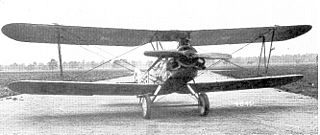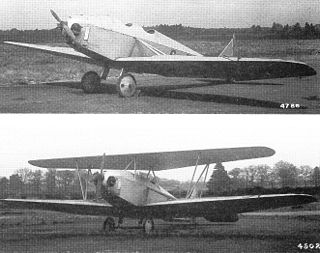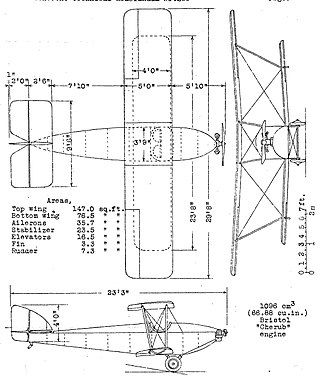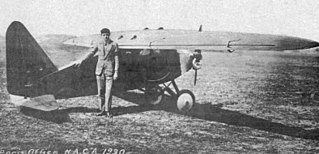
The Hawker Cygnet was a British ultralight sesquiplane aircraft of the 1920s.

The Vickers Virginia was a biplane heavy bomber of the British Royal Air Force, developed from the Vickers Vimy.

The ANEC I and ANEC II were 1920s British single-engine ultralight aircraft designed and built by Air Navigation and Engineering Company Limited at Addlestone Surrey. One was privately constructed in Brisbane, Australia.

The Roe I Triplane was an early aircraft designed and built by A.V. Roe which was the first all-British aircraft to fly..

The Bristol Taxiplane and Bristol Primary Trainer were British single-engine biplane light aircraft built by the Bristol Aeroplane Company in the early 1920s. A total of 28 were built, being mainly used as trainers.

The Supermarine S.5 was a 1920s British single-engined single-seat racing seaplane built by Supermarine. Designed specifically for the Schneider Trophy competition, the S.5 was the progenitor of a line of racing aircraft that ultimately led to the Supermarine Spitfire.
The Nieuport London was a British night bomber aircraft designed in the First World War. A twin-engined triplane, the London was dogged by the unavailability and unreliability of its engines, and did not fly until 1920. Only two were built.
The Sopwith Snapper was a prototype British fighter aircraft of the First World War. A single-engined biplane designed by the Sopwith Aviation Company to replace the Sopwith Snipe fighter, it first flew after the end of the war, but did not enter service owing to the failure of its engine, only three aircraft being built.

The Vickers Type 253 was a single-engined two-seat biplane general-purpose military machine built to a 1930 government specification. It won a production contract, but this was transferred to the same company's monoplane equivalent, the Wellesley. Only one Type 253 was built.

The Blackburn Sidecar was a two-seat ultra-light aircraft built by the Blackburn Aeroplane & Motor Company at Brough in 1919. There is no evidence that it ever flew.
The Boulton & Paul P.6 was a one-off conventional single-engined biplane built by Boulton & Paul Ltd to test the aerodynamics of different airfoil sections. It was later used as the company sales machine.

The Parnall Pixie was a low powered British single-seat monoplane light aircraft originally designed to compete in the Lympne, UK trials for motor-gliders in 1923, where it was flown successfully by Norman Macmillan. It had two sets of wings, one for cross-country flights and the other for speed; it later appeared as a biplane which could be converted into a monoplane.

The Cranwell CLA.4 was a single-engined two-seat inverted sesquiplane designed and constructed for the 1926 Lympne trials by an amateur group from RAF College Cranwell. Two were entered, though engine problems prevented one from taking part; the other was eliminated with a broken undercarriage. A third aircraft was amateur-built in Canada and flew until 1934.

The Cranwell CLA.3 was a parasol winged single-engined, single-seat British aircraft built to compete in the Lympne air races of 1925. It was designed and built by an amateur group drawn from staff and pupils at the RAF College Cranwell. Though it won one prize and set a Class record, only one CLA.3 was made.

The Cranwell CLA.2 was a single-engined two-seat biplane built by staff and students of RAF College Cranwell as an entrant to the Lympne Two Seater Light Aeroplane Trials of 1924. It won the reliability prize.
The Parnall Parasol was an experimental parasol winged aircraft design to measure the aerodynamic forces on wings in flight. Two were built and flown in the early 1930s in the UK.
The Clarke Cheetah was a single-engined amateur built aircraft built in the UK using some parts from a de Havilland Humming Bird to produce a machine that could fly either as a biplane or as a parasol winged monoplane. The single example flew for five years before being converted again in 1936.
The Howard Wright 1910 Monoplane was an early British aircraft. It was one of a series of similar designs built by Wright, then one of Englands foremost aircraft engineers, between 1909 and 1910. Three of these were on display at the 1910 Aero show at Olympia. The noted English pioneer aviator and aircraft designer Thomas Sopwith learnt to fly in an example.

The Peyret-Mauboussin PM X, PM 4 or Mauboussin M.10 was a low power, single-seat, high wing cantilever monoplane. Only one was built but it set several records in the under 250 kg (550 lb) class both as a landplane and a floatplane.

The Lachassagne AL 5 was a French low power, single seat sports aircraft with novel, in-flight variable camber wings and tailplane. It first flew in 1930; at least two were built.















